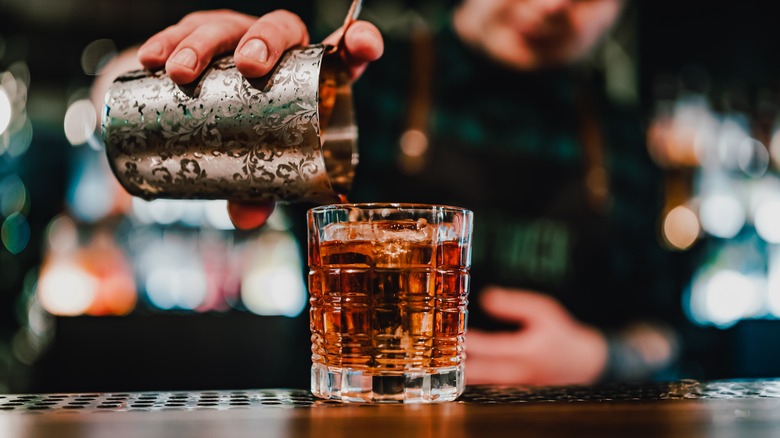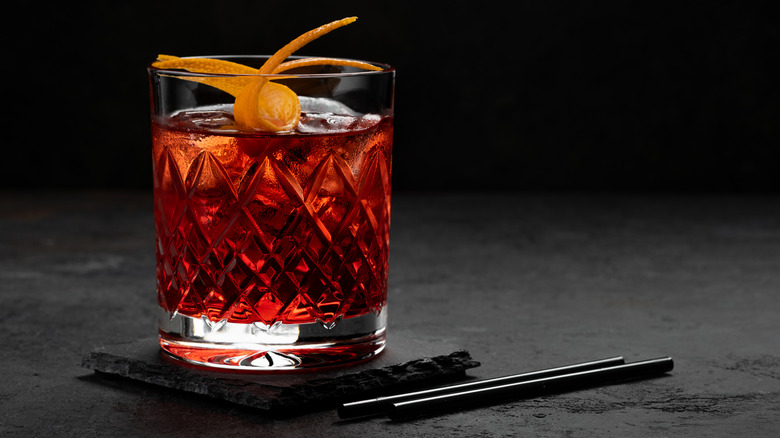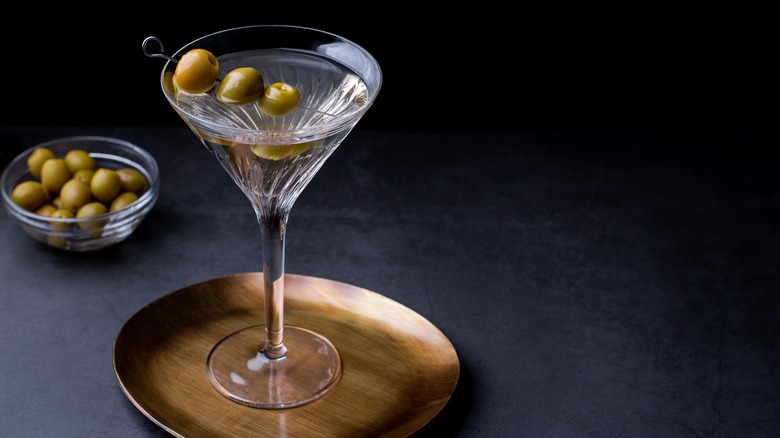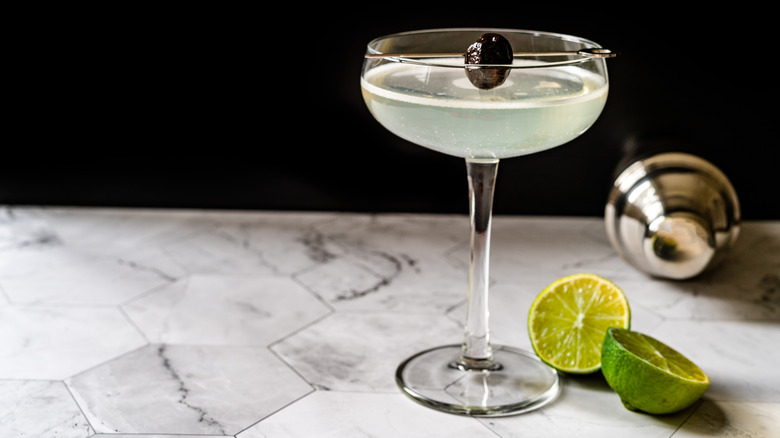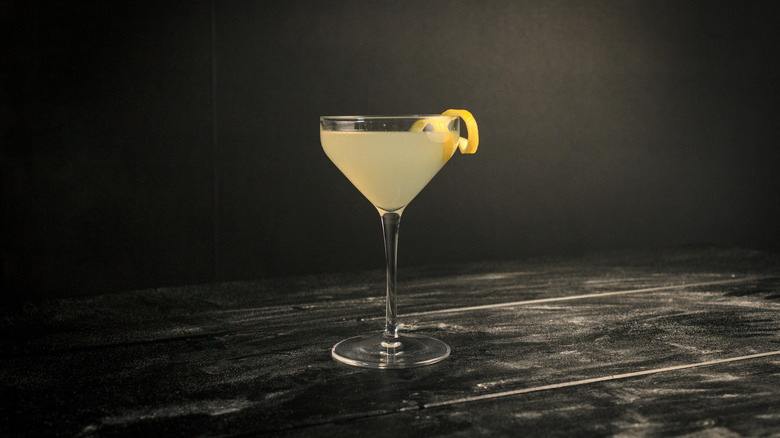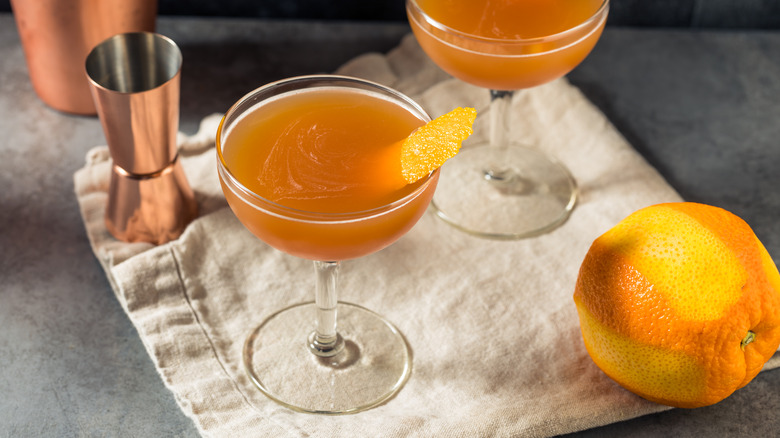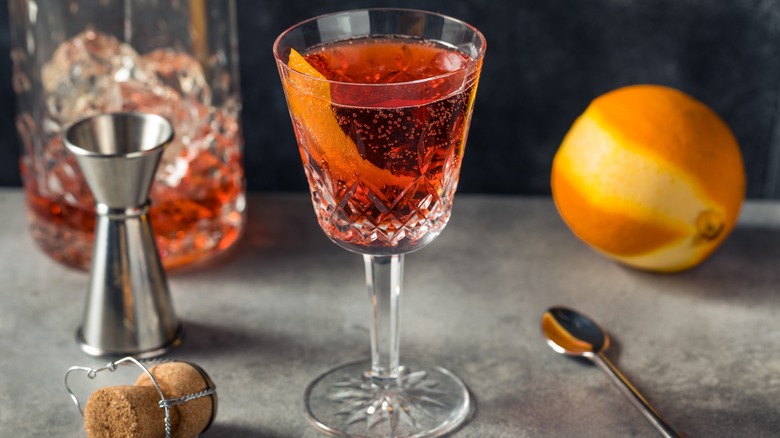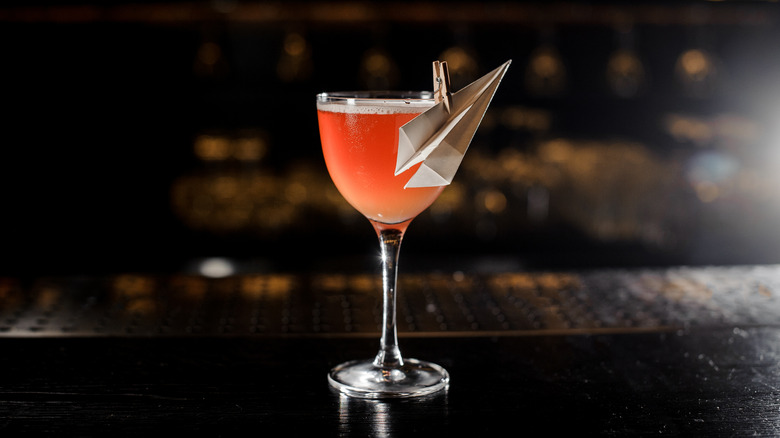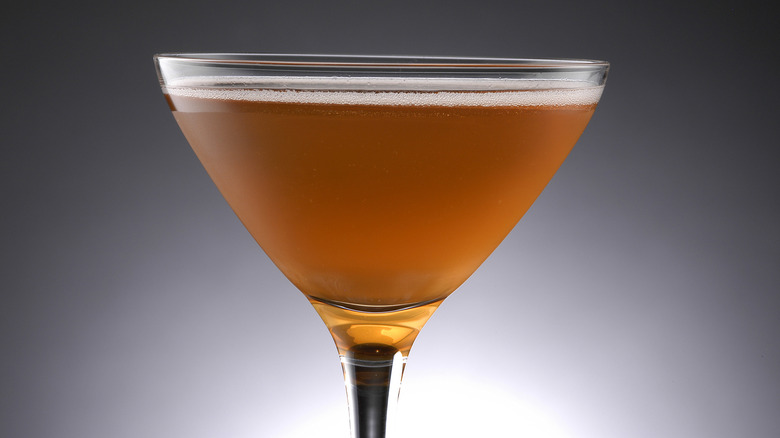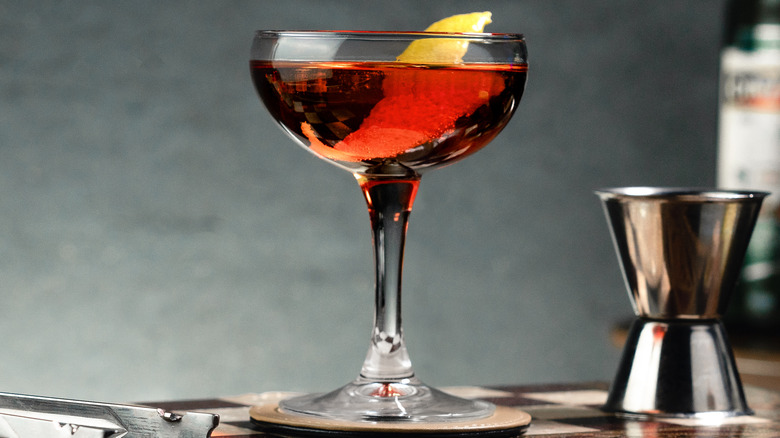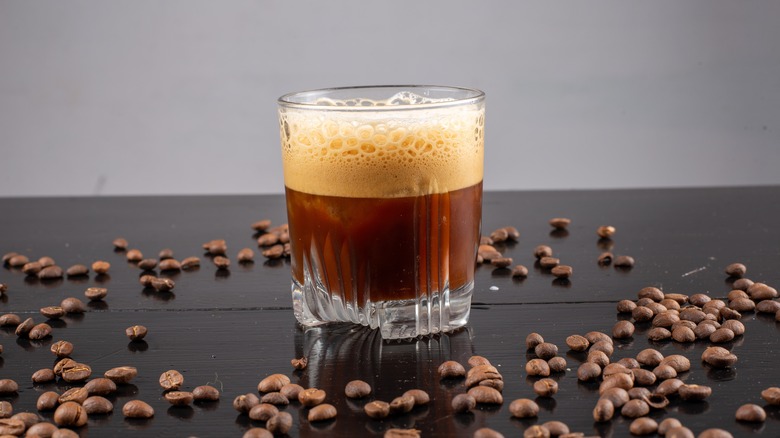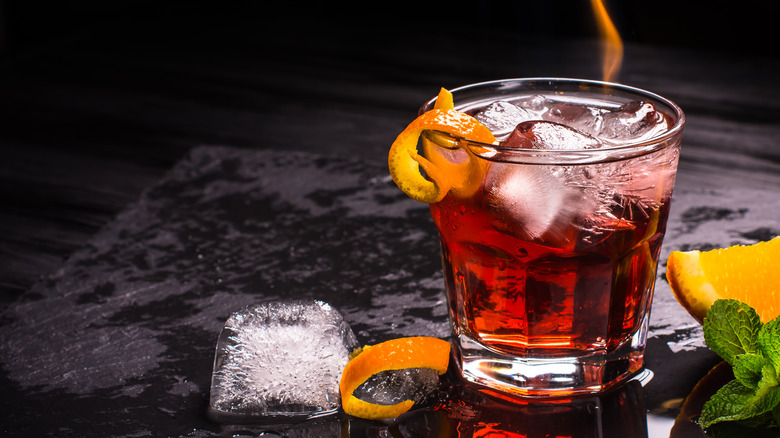11 Equal-Parts Cocktails You Need To Try
There are few things better than mixing a delicious cocktail at the end of a long day of work, to kick off the weekend, or to celebrate time spent with friends or family. What's even better is not having to think about how much of each ingredient goes into your glass or shaker. The simple pleasure of an equal-parts cocktail is that they're not only easy to remember, but they also allow you to stretch the bottles in your home bar longer, since each cocktail only calls for an ounce, or less, from each bottle.
Additionally, the wide array of equal-parts cocktails transcends both time and taste. These types of drinks are popular for a reason, and they have been made, sustained, and reinvented for over a century. There are equal-parts cocktails that are timeless classics, modern revelations, and riffs on the two that have become masterpieces of their own. Here are a few of each to get started.
Negroni
The classic Negroni is not only the undisputed king of equal parts cocktails, but it may also be on the Mount Rushmore of cocktails altogether. The Italian-born drink has inspired countless variations, but the original cocktail itself was actually a riff.
At the time it was created, one of the most popular cocktails around was the Americano, an equal parts combination of sweet vermouth and Campari that was topped off with soda water. In Florence in 1919, Count Camillo Negroni entered a bar and requested that the bartender strengthen his Americano. The bartender obliged, substituted the soda water with a London Dry gin, and Italy's greatest export was born (via Condé Nast Traveller).
The Negroni is as close to a perfect cocktail as there is, each ingredient contributing something special to be detected and savored on its own while also contributing to an unparalleled, harmonious balance. The intense bitterness of the Campari is tamed by the mellowing softness of the sweet vermouth. Meanwhile, the gin cuts through with strength and sharpness.
If you have never had a Negroni, you must approach your first one with the understanding that Campari is an acquired taste. Ask anyone who loves a Negroni, and most will tell you they did not like it at first. It is quite bitter, but even if your first sip scares you away — which it very well might — coming back for another try and another after that may just lead you to your new favorite cocktail.
50/50 Martini
The Martini is undoubtedly the most famous cocktail ever, but the many ways it can be made is a very personal preference. Classic, dry, very dry, reverse, gin, vodka, twist, olives, dirty, shaken, and stirred are all requests that can be made to a bartender either singularly, in tandem, or even more. If you have yet to dive into the world of martinis and are a bit overwhelmed by the vast terminology surrounding them or are a bit weary of a cocktail that is nothing but booze, the 50/50 martini is an excellent place to start.
The 50/50, as you might assume, is equal parts your preferred liquor and dry vermouth. This makes for a far easier-sipping cocktail that still protects the botanicals and dryness of the gin without overpowering it. Technically, the measurements of a classic martini do make a more balanced drink, and mixing a martini with equal parts gin and vermouth may cause martini purists some strife, but enjoying the cocktail you like is the only thing that matters.
In fact, legendary bartender Audrey Saunders prefers an equal parts martini, and her "Fitty-Fitty" brought it into the public eye through the opening of the Pegu Club in 2005 (via Punch). She claims that the 50/50 places more of an emphasis on culinary balance as opposed to drinking for the sake of inebriation. So don't ever worry about what people may think of your drink order. A cocktail icon has your back.
Last Word
The Last Word is a pre-Prohibition cocktail and also the first shaken drink on the list. It was first published in a 1916 edition of the Detriot Athletic Club's magazine. The originally written reference did not include a recipe, however — just its price of 35 cents, double that of a Manhattan. Decades later, in 1953, an actual recipe for the Last Word was included in Ted Saucier's "Bottoms Up!", per Difford's Guide. The equal-parts combination of gin, lime juice, maraschino liqueur, and green chartreuse has been a hit since its creation but was rejuvenated with the cocktail boom of the 21st century.
Of course, any equal-parts cocktail that has lasted this long is worth trying because of that guaranteed balance, but the chartreuse is an exceptionally unique spirit well-deserving of a place on your home bar for more cocktails than just this one. According to Taste France, chartreuse is a French herbal liqueur that has been made since 1737. It is made in the town of Voiron using 130 herbs and botanicals that infuse a grape-based spirit to create a distinctly unique concoction that contributes to a wide range of excellent cocktails.
At 55% alcohol, green chartreuse especially packs a punch but is perfectly balanced by the sweetness of maraschino liqueur, brightened by the lime juice, and botanically highlighted by the gin. If you happen to come across this drink on a cocktail menu, give it a try and you will not be disappointed.
Corpse Reviver #2
Corpse reviver cocktails have been around since the 1880s, a category referring to cocktails that contain a variety of spirits that are sure to enliven the drinker, per Tales of the Cocktail. It was not until 1930, however, that the cocktail was officially published in two different styles, the Corpse Reviver #1 and the Corpse Reviver #2. Harry Craddock is responsible for solidifying both in his "Savoy Cocktail Book" in which he says that drinking four of the Corpse Reviver #2 will leave you feeling far less than revived. This may scare off anyone unfamiliar with the cocktail, but this equal parts combination of Cointreau, Cocchi Americano, lemon juice, and gin poured over an absinthe rinse is an exceptional balance between potent and smooth.
This cocktail is essentially a dressed-up gin sour. The gin and lemon juice provide an instantly recognizable flavor and texture, but the tartness is balanced nicely by the sweet, orange flavor from the Cointreau. Cocchi Americano is a quinine-forward aperitif that has an alcohol content of 16.5%. This plays really well with the anise flavor from the absinthe rinse, the two combining to mellow out the brightness from the other ingredients. The next time you overdo it on a night out, a quick shake of this drink is sure to get you back to feeling your best — but maybe just have one.
Blood and Sand
The Blood and Sand is one of the more polarizing cocktails on this list. Originally created in London for a 1922 film of the same name, the drink contains an equal parts combination of scotch whisky, Cherry Heering, sweet vermouth, and orange juice and was first published in Harry Craddock's 1930 "Savoy Cocktail Book," mentioned earlier. So what makes this drink so contentious?
According to Punch, the main subject of debate is that this equal parts cocktail should not be equal parts, because the alcohol balances itself so well that the cocktail merely tastes like orange juice and alcohol. Some have suggested bumping up the scotch and vermouth, and others have challenged the inclusion of orange juice altogether. Regardless, The Blood and Sand has been sustained as a part of cocktail culture for a century now, so it has to be doing something right.
If you find that the original Blood and Sand is not quite for you and want one of the many modern revisions out there, a swap of orange juice for orange liqueur is a common one that keeps the measurements the same while also fixing the fundamental imbalance. The drink will still get sweetness and flavor from an orange ingredient, and the scotch, sweet vermouth, and Cherry Heering will keep intact and not get overpowered by the sweet, acidic, and cloudy orange juice.
Negroni Sbagliato
Some cocktails are created through carefully calculated trial and error, some by catching lightning in a bottle, and some are born purely by accident. There is no better example of this than the Negroni Sbagliato. According to La Cucina Italiana, this Negroni variation was created by Mirko Stocchetto, a bartender at Milan's Bar Basso in 1971. When a customer ordered a Negroni, he added the Campari and sweet vermouth to a glass and then, by mistake, Prosecco instead of gin, and the Negroni Sbagliato — or "mistaken Negroni" — was born. Luckily, the customer fell in love and the drink became an instant hit, and many people preferred this take on the classic Italian cocktail.
For those who may find the classic Negroni a little too bitter or punchy for their taste, the Negroni Sbagliato is a lighter, sweeter, more approachable cocktail. Even if you have yet to try a Campari cocktail, this may be the one to do so. The bitterness of the Campari is tamed in tandem with the sweet vermouth, and the sparkling wine adds another sweet component while cutting up the spirits to achieve a more seamless palatability. The substitute of Prosecco for gin not only adds an extra layer of bubbly vibrance but also lowers the alcohol considerably, making it an even better aperitif cocktail to begin an evening. If the recent internet fad of this cocktail was not enough to get you to try one, consider this your deal breaker.
Paper Plane
Of all the riffs on The Last Word, none have made as big an impact on the world of cocktails as the Paper Plane. This modern classic cocktail was created at The Violet Hour in Chicago in 2008 by Sam Ross, who was asked by his friend, Tobey Maloney, to create a new cocktail for the opening of the new bar (via Punch). The cocktail was born out of direct inspiration from The Last Word, only this one containing bourbon, Campari, Amaro Nonnino, and lemon juice. The name came from the song by M.I.A., which was playing when Ross called Maloney about his new creation.
Upon another try of the cocktail days later, however, Ross was not quite happy with the balance of the drink and decided to use Aperol instead of Campari. Then, he realized he had struck gold. Aperol, another Italian aperitivo, is not as bitter as Campari. Instead, its flavor is more orange and fruit-forward, which is directly complimented by the herbal notes of the Amaro Nonnino, another Italian spirit. The bourbon swap for gin makes turns this bright drink into a darker one with those barrel notes that elongate a warmer finish.
Describing why the Paper Plane is good is not very simple. All of the ingredients are so different from one another that it's difficult to say how exactly the drink works — it just does. And there's no way to truly know what it's really about without tasting it for yourself.
Adonis
The Adonis is another pre-Prohibition era cocktail with a low ABV. The 50/50 combination of sherry and sweet vermouth stirred with bitters and served up is a classic dating back to 1884, according to Punch. The drink was named after a Broadway musical and its original recipe does not specify which type of sherry should be used, which has led to another cocktail debate.
According to bartender Adam Bernbach, the only sherry fit for an Adonis is oxidative sherry, such as amontillado. The problem is, when most people hear of an Adonis and see that it calls for sherry, they automatically reach for fino sherry, which contains more salinity and has a drier flavor and finish. Bernbach believes the nuttier, spicier oxidative sherries are better alongside the sweet vermouth in an Adonis, because of the complimentary profiles.
Regardless, like any disputed cocktail, the forms it is made in should reflect your own personal preference and taste. The Adonis an easy-sipping, lower-alcohol drink that gives you the opportunity to discover your preferred take on your own. Play around with different sherries, different vermouth, and different bitters, and turn this cocktail into your very own.
Old Pal
Yes, it's another Negroni variation, but the Old Pal changes two of the original ingredients to turn the cocktail into another revelation. This cocktail was first published in Harry McElhone's 1922 "Harry's ABC of Mixing Cocktails" (via Cold Glass). McElhone is also responsible for the Boulevardier, which swaps out the gin in a Negroni for bourbon, and that is where the Old Pal comes from, but this cocktail is actually credited to a man named William "Sparrow" Robinson.
Robinson was a sports writer for the New York Herald Tribune at their office in Paris, where McElhone lived and worked as a bar owner and bartender. Robinson was known to refer to anyone he interacted with as his "old pal," including McElhone, who frequently mixed Robinson his favorite cocktail of rye whiskey, Campari, and dry vermouth. The recipe was included in McElhone's book, and the Old Pal has stood since.
The Old Pal is essentially a more nuanced Boulevardier. It includes a spicy forward rye whiskey and swaps the sweet vermouth for dry to create an entirely unique variation that is nuanced in every department. The barrel notes of the whiskey help it to stand up to the sharpness of the Campari and dry vermouth, which pair wonderfully between their fruity and herbal profiles. The Old Pal is definitely a more bitter cocktail, and maybe not the best first introduction to Campari, but if you like a Negroni, you have to try an Old Pal.
Carajillo
The Carajillo may be the cocktail on this list with the most bang for its buck. This drink consists of just two ingredients and the combo makes for one of the best pre or post-dinner time cocktails there is. The Carajillo is made up of espresso and Licor 43, a Spanish liqueur, according to Punch. The cocktail is originally from Spain, but it has since become one of Mexico's go-to drinks, the perfect pick-me-up to either kick off the night or keep it going.
The current rendition of the Carajillo is not the original, however, which hails from Cuba and was a combination of coffee and rum. Regardless, the cocktail now belongs to the youth of Mexico, who have turned the Carajillo into their counterpart of the American vodka-red bull, Punch claims.
The name for Licor 43 comes from the advertised number of ingredients that go into it, such as Mediterranean citrus and other botanicals. The flavor of the liqueur is difficult to pinpoint, but the best way to describe is just that it's sweet. It may sound like nothing special, but a simple mix with espresso over ice and you have yourself an undeniably delicious kick in the rear.
Mezcal Negroni
One more Negroni variation then we can get out of here. The only Mezcal cocktails widely known today are really only as old as the cocktail resurgence of the past few decades. The birth of the Mezcal Negroni is exactly what makes the world of cocktails ever-evolving.
As hammered home throughout this article, an equal-parts cocktail template paves the way for simple experimentation to make new drinks that are new but familiar. In the mid-2000s, classic cocktails like the Negroni were revitalized and thrown back into the mainstream drinking scene (via Punch). Simultaneously, mezcal was being utilized for cocktails really for the first time ever, so a swap of the spirit was only natural. The result was a cocktail that will likely never — and should never — leave a menu.
Mezcal and tequila are both made from agave, but mezcal is made by cooking the agave in an underground pit. This is what gives mezcal its peaty, smoky flavor, which contributes to a Negroni like no other. The sweetness of the agave teams up with the vermouth to stand up to the bitter Campari and the smoke provides an undertone of smoldering warmth. What makes Negroni variations great is that even if a bar doesn't have a Mezcal Negroni on its menu, a request for this simple substitution gets you one in no time. If the bartender has the sense to try it for theirself, it will surely be on the menu the next time you stop by.
